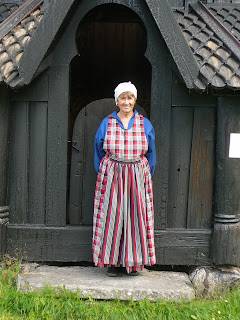Oye Stave Church,
from second half of 12th century, Municipality of Vang,
Oppland
Photographed in 2011
The stave church in located in the village of
Oye, which is part of Vang Municipality in
Oppland County, Norway – just
about half way between Oslo and Bergen. It is a rather small church, it has
several unusual features, it has an unusual history and it is one of the oldest
stave churches, if not the oldest.
When the church was constructed on the shorts
of Lake Vangsmjose in the 12th century,
almost immediately, the church began to have problems with flooding from the
spring thaws. This flooding affected the cemetery surrounding the church more
than the church itself. At times, during flooding, corpses were literally
flushed out of graves. Also, burials were extremely complicated when the burial
space for a casket was filled with water. Thus, began a period of putting
stones in caskets in order to lower them down and to hold them down.
Finally, it was decided to move the church up
to higher ground. In the 1700s, the stave church was in bad condition and the
parishioners decided to build a new church. The stave church was torn down and
the new church was built on the exact same spot and was completed in 1747. Out
of respect for the old church, some of its wood and one of its portals were
used in the new church. Now, skip ahead about 200 years. In the 1930s, the
‘new’ church needed a new floor. It was at this time that 156 pieces of the old
stave church were found beneath the floor boards of the ‘new’ church.
Soon, the reconstruction of Oye stave church
was contemplated. The 156 pieces were registered by the Central office of
Historic Monuments and stored until a reconstruction of the church could be
initiated. This reconstruction took place in the 1960s.
The roof and north wall are completely new, but
a large share of the rest of the church has been reconstructed from the wood of
the original church from the 12th century (e.g. the staves).
There is a
covered walkway (ambulatory) around three sides of the church. Two sides of the
walkway have arches but the walkway on the north side is closed and very dark
(evil things come from the north).
The church portal is carved like those in most
stave churches (This photograph shows a portion of the interesting carving).
But unlike most stave churches, the portal is exceptionally narrow and tall and
the step into the church vestry is high.
Another unusual feature of this church is that
there is a wall separating the nave from the chancel area. (like in a Russian
Orthodox church). The carved doorway from the nave to the chancel is narrow. The
original carving around the doorway is in an Oslo museum. The crucifix above the altar,
which I was asked not to photograph close up, is from the medieval period. The
crucifix is from around 1200 and the Christ figure is from around 1300. There
are pews but only along the walls.
Runic inscriptions can be found in various
places in and around the church. One runic inscription inside the church states
that it was consecrated on September 29, but the year is not given. Since St. John the Baptist died
on that date, some consider that the church may have been dedicated to him.
Before the Black Death, about 100 people
attended the church. By the end of this dreadful period, there were only about
30 church members.
Oye stave church’s interesting and
knowledgeable guide.
There are five other stave churches in the
area: Hore, Lomen, Hegge, Reinli and Hedalen. They are all on or close to
Highway E18. Actually, Oye stave church is not that far from Borgund stave
church.






No hay comentarios:
Publicar un comentario